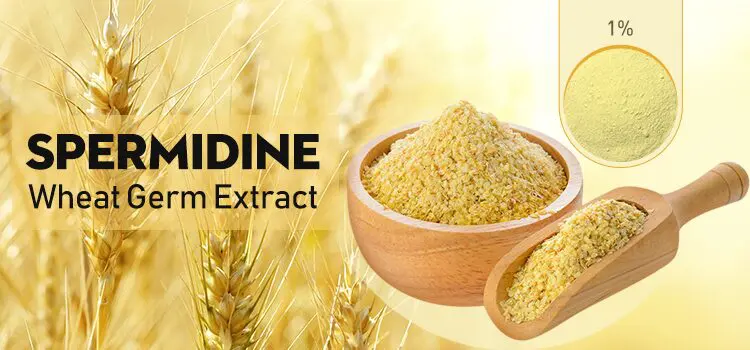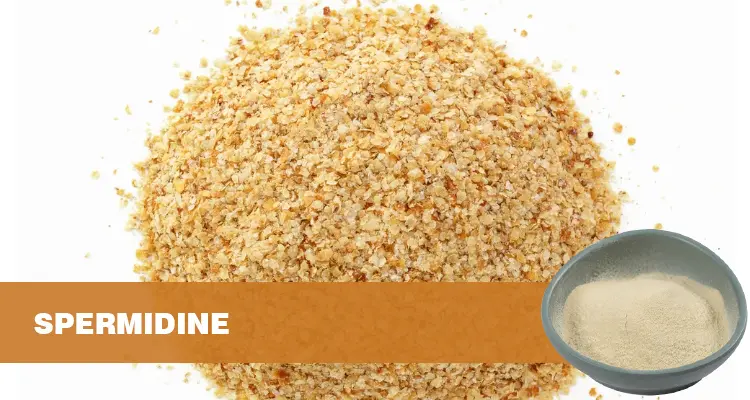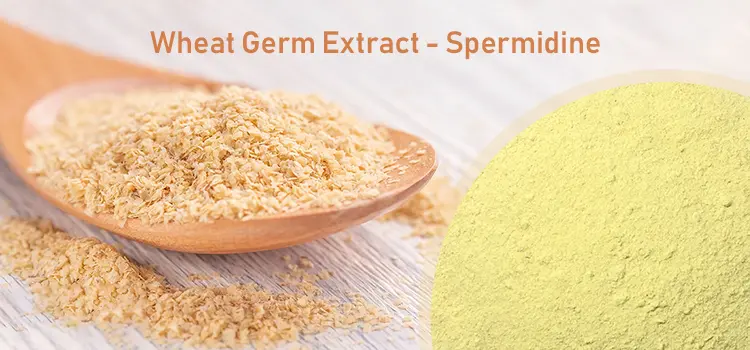Reproductive health is undoubtedly a crucial component of life’s wondrous journey. It not only affects individual well-being but is also closely linked to human reproduction. Within this shrouded realm of reproduction, spermidine, a mysterious “guest,” is gradually emerging and attracting the attention of numerous researchers. Spermidine, a naturally occurring polyamine, is widely distributed throughout organisms, from microorganisms to plants and animals. Despite its seemingly ordinary nature, it plays a crucial role in reproductive health, like a key that unlocks the secrets of reproductive health.
Spermidine and Male Reproductive Health
Spermidine plays a crucial role in the intricate and complex “microcosm” of the male reproductive system. It profoundly influences sperm production, development, maturation, and the normal physiological properties of semen, making it a crucial safeguard for male reproductive health.
The “Guardian” of Sperm
During sperm production and development, cells undergo a series of complex metabolic activities, which inevitably produce free radicals. Free radicals are like troublemakers, possessing strong oxidative activity. If left unchecked, they can attack sperm’s DNA and cell membranes. Damage to sperm DNA can lead to genetic mutations, impacting normal embryonic development. Damage to the cell membrane can also destabilize sperm, preventing them from swimming properly and fertilizing the egg. Spermidine, a powerful antioxidant, acts like a loyal “guardian,” capturing and neutralizing these free radicals, preventing them from damaging sperm and protecting the integrity of sperm DNA and cell membranes, thereby maintaining sperm quality.
A “Booster” for Sperm Motility
For sperm to successfully fertilize an egg, they must possess excellent motility, enabling them to swim quickly and accurately toward the egg. Research has found that spermidine plays a key role in sperm motility. It regulates ion balance within sperm cells, particularly calcium ion concentration. Calcium ions play a crucial role in sperm motility. A suitable calcium ion concentration activates motor proteins in the sperm tail, causing it to rhythmically oscillate and propel the sperm forward. When spermidine is deficient, the ion balance within sperm cells is disrupted, leading to abnormal calcium ion concentrations. This significantly reduces sperm motility and vitality, making it difficult for sperm to swim within the female reproductive tract and reach the egg, significantly reducing the chance of fertilization.
The “Shaper” of Sperm Morphology
Normal sperm morphology is a crucial prerequisite for fertilization. Sperm has a unique morphological structure, with the head carrying genetic material and the tail providing motility. Spermidine plays an essential role in maintaining normal sperm morphology and structure. It participates in the construction and stability of the sperm cytoskeleton, which acts as the sperm’s “internal scaffolding” and determines its shape. Spermidine promotes the polymerization of tubulin, forming a stable microtubule structure. These microtubules not only support the sperm head and tail but also participate in material transport and signal transmission. A lack of spermidine disrupts the sperm cytoskeleton, leading to abnormal sperm morphology, such as an oversized or undersized head and a curved or missing tail. These sperm with abnormal morphology often have poor motility and struggle to fertilize the egg. Even if fertilization is successful, the risk of abnormal embryonic development may increase.
The “Regulator” of Semen Coagulation and Liquefaction
After ejaculation, semen undergoes a process of coagulation followed by liquefaction. Immediately after ejaculation, semen rapidly coagulates, helping it to remain within the female reproductive tract and prevent it from leaking out. Subsequently, semen liquefies over a period of time, allowing sperm to swim freely and facilitate their descent to the egg. Spermidine plays a “regulatory” role in this process, influencing the activity of various proteins and enzymes in semen, thereby regulating semen coagulation and liquefaction. Specifically, spermidine regulates the interaction between coagulation proteins and liquefaction enzymes, ensuring the normal coagulation and liquefaction processes of semen. Abnormal spermidine levels can disrupt semen coagulation and liquefaction, resulting in, for example, semen failing to coagulate or taking too long to liquefy. This can negatively impact sperm survival and motility, and thus male fertility. (V) A Multifaceted Helper for the Male Reproductive System
Spermidine’s effects are not limited to its effects on sperm; it serves as a multifaceted helper for the male reproductive and urinary systems. It regulates the overall function of these systems and maintains their normal physiological state. In prostate tissue, spermidine can play a protective role, preventing diseases such as prostatitis and benign prostatic hyperplasia (BPH). Prostatitis and BPH affect the secretion of prostatic fluid, a crucial component of semen. Changes in its composition and properties can negatively impact sperm quality. Furthermore, spermidine is closely linked to male erectile function and libido. It improves blood supply to the corpus cavernosum by regulating the release of neurotransmitters and vasoactive substances, thereby enhancing erectile function. It also influences the neuroendocrine system in the brain, boosting libido and improving the quality of sexual life, thus supporting male reproductive health in multiple ways.
Spermidine and Female Reproductive Health
Spermidine plays an indispensable role in the female reproductive process, acting like a silent, unsung hero, actively contributing to multiple key processes and safeguarding women’s reproductive health.
A Catalyst for Ovulation
Ovulation maturation is a crucial step in the female reproductive process. Only a mature egg can fertilize with sperm and begin the journey of life. In animal model studies, scientists have discovered a surprising phenomenon: supplementation with spermidine significantly promotes oocyte maturation and ovulation. This discovery offers new hope for addressing fertility issues caused by oocyte maturation disorders or abnormal ovulation. Spermidine’s mechanism of promoting oocyte maturation may be related to its regulation of intracellular signaling pathways. It activates a series of protein kinases involved in oocyte maturation. These kinases act like “small switches,” initiating the various physiological processes of oocyte maturation, enabling the oocyte to successfully complete meiosis and reach maturity. Spermidine also regulates hormone secretion in the ovaries, creating a favorable endocrine environment for oocyte maturation and ovulation. For example, it can promote the release of gonadotropins and enhance the sensitivity of follicles to gonadotropins, thereby promoting follicular development and egg maturation.
“Improvers” of Endometrial Receptivity
After successful fertilization, the fertilized egg must implant on the endometrium before further development into an embryo. Endometrial receptivity is a key factor influencing the success rate of embryo implantation. The endometrium is like “soil”—only when the soil is fertile and suitable can the seed (fertilized egg) take root and grow successfully. Spermidine plays a key role in improving endometrial receptivity. Research has shown that spermidine supplementation can regulate gene expression in endometrial cells and promote the secretion of various cytokines and adhesion molecules that promote embryo implantation. These cytokines and adhesion molecules act like “glue,” strengthening the adhesion between the fertilized egg and the endometrium, making it easier for the fertilized egg to implant. Furthermore, spermidine improves blood circulation in the endometrium, providing the embryo with sufficient nutrients and oxygen, creating favorable conditions for development.
A “ray of hope” for restoring oocyte quality
With aging, women’s reproductive capacity gradually declines, an inevitable physiological process. Declining oocyte quality is a key factor contributing to this decline. Studies have found that spermidine levels in the ovaries of aged female mice decrease significantly, and oocyte quality also declines, indicating signs of ovarian aging. However, supplementing with spermidine significantly restored oocyte quality and significantly improved fertility in aged female mice. Further research revealed the secret: spermidine enhances mitochondrial autophagy, clearing damaged mitochondria and improving mitochondrial function. Mitochondria are the cell’s “energy factories” and are crucial for the development and function of oocytes. When mitochondria are damaged, the oocyte’s energy supply is insufficient, compromising its quality and developmental potential. Spermidine enhances mitochondrial autophagy, promptly clearing these “problematic mitochondria” and restoring normal energy metabolism in oocytes, thereby restoring oocyte quality and fertility. Excitingly, similar effects of spermidine have been observed in aged porcine oocytes, suggesting that this mechanism of action may be conserved across species. This research finding offers new hope for extending women’s reproductive lifespan. Perhaps in the near future, spermidine supplementation will help more older women achieve their dream of having children, providing a new strategy and approach to addressing human fertility issues.
Precautions for Spermidine Supplementation
Although spermidine has many benefits for reproductive health, it should be used with caution. Excessive spermidine intake may have potential adverse effects. Some believe that excessive spermidine intake can lead to a loss of calcium and vitamin B₁₂ in the body, potentially leading to long-term health problems such as anemia and osteoporosis. While scientific evidence regarding these side effects remains controversial, for safety reasons, it is important to strictly control the dosage of spermidine supplements and avoid excessive intake. Furthermore, spermidine may interact with certain medications, affecting their efficacy or causing adverse reactions. For example, those taking anticoagulants or antihypertensive medications should exercise extreme caution before taking spermidine supplements. Therefore, before considering spermidine supplementation, it is crucial to consult a doctor or a professional nutritionist. They can provide personalized guidance based on factors such as individual health status, dietary habits, and current medications, ensuring the safety and effectiveness of spermidine supplementation and enabling it to better contribute to reproductive health and overall well-being.
Summary and Outlook
Spermidine, a rising star molecule in the field of reproductive health, has demonstrated remarkable and significant effects in maintaining sperm quality and regulating semen physiology in male reproductive health, as well as in egg maturation, improving endometrial receptivity, and restoring oocyte quality in female reproductive health. It provides new insights and potential intervention targets for addressing reproductive health issues. While research on spermidine in reproductive health has yielded some promising results, this represents only the tip of the iceberg. There are still many unknowns to explore, such as whether the specific mechanism of action of spermidine varies among individuals and under different physiological and pathological conditions, and how to safely and effectively supplement spermidine to achieve optimal reproductive health outcomes. With the continuous advancement of science and technology and the deepening of research, we believe that in the near future, more research results will emerge on spermidine in the field of reproductive health, bringing greater hope and possibilities for improving human reproductive health. Let us all look forward to spermidine shining even brighter in the reproductive health arena and making greater contributions to human reproduction and well-being.





















